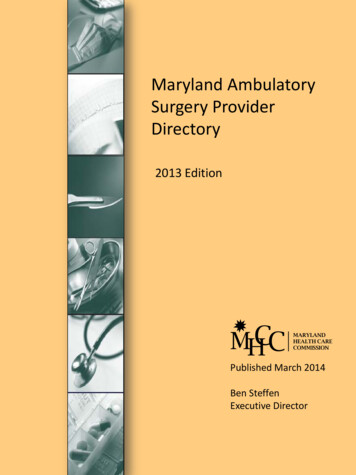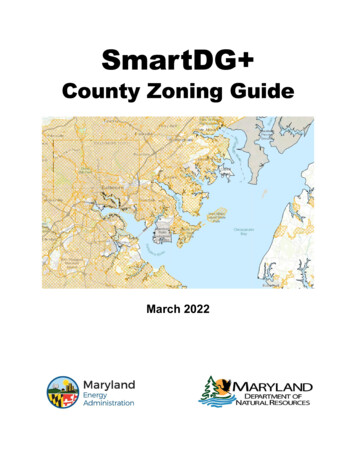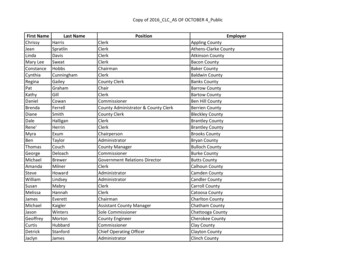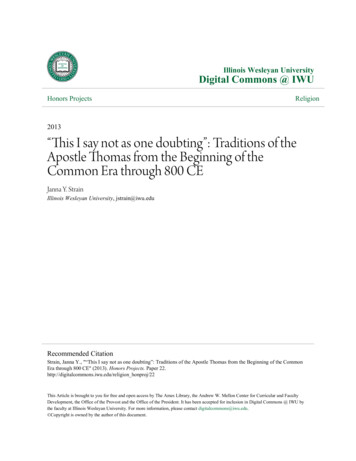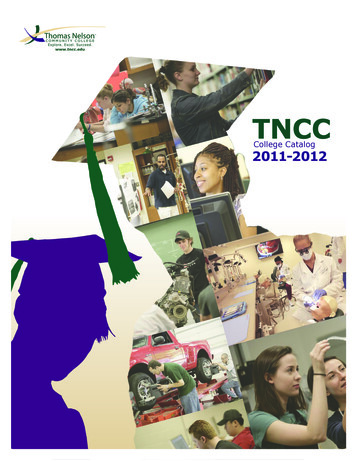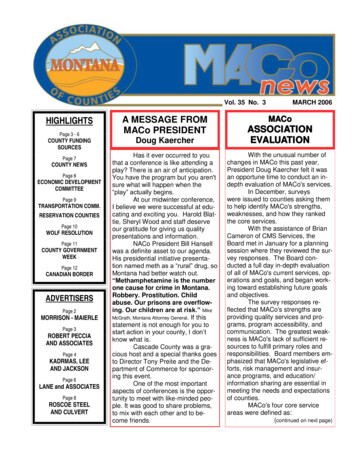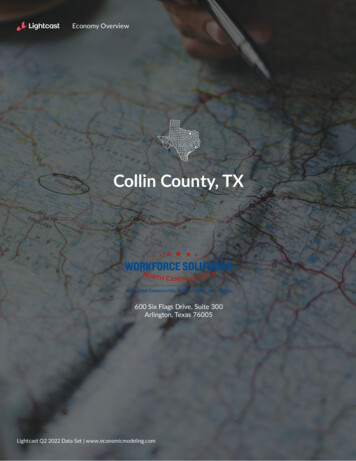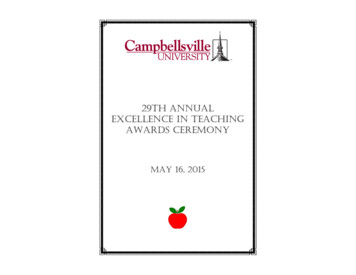
Transcription
Thomas County School SystemThomasville, GeorgiaThree-Year Technology PlanJuly 1, 2012 – June 30, 2015Draft Creation Date: February 21, 2012Approved by the Georgia DOE: June 30, 2012SuperintendentDr. George H. Kornegay, Jr.Director of Instructional TechnologyMrs. Danna Golden(229) 225-4380dgolden@rose.net1
Thomas County SchoolsSystem Vision/MissionTeaching Children, Ensuring Success promoting academic excellence in a safe and supportive learning environment,understanding the individual emotional, intellectual, physical, and social needs of allchildren,demonstrating a unified commitment to preparing students with skills and strategies neededto successfully adapt in a diverse and ever-changing society,remaining sensitive to cultural differences,providing state-of-the art facilities,utilizing research-based instruction, andmeeting the professional needs of all staff members.Technology VisionThe integration of collaboration, computer- assisted instruction, and good teaching canbecome tools in the service of rich curricula, enhanced pedagogies, more effective organizationalstructures in schools, stronger links between schools and society and the empowerment ofdisenfranchised learners. Technology-enhanced instruction, more technology resources, trainedteachers, and classroom access to instructional software and Internet resources will allowteachers to more effectively integrate instructional methods that promote inquiry andcomprehension as well as oral and written communication skills. Teachers can presentinformation in ways that are most effective in facilitating a deeper understanding of content. Theelements of a 21st century educational program will help produce students who are literate intechnology as well as all forms of communication skills and who are able to selectively retrieve,analyze, and use material to apply higher order work.In Thomas County, we know that vision without action is merely a dream. Action withoutvision just passes time. But vision with action can change the world. Thomas County’s schoolimprovement process is helping to prepare students to be life-long learners in a 21st centuryclassroom.Belief Statements Student learning is the primary focus of our school system. Quality staff is imperative for student achievement. High performing schools require collaboration.2
Students achieve best when engaged in challenging, integrated learning experiences. School must be a safe and supportive place. School must prepare students for the changing future with the support of technologyenhanced instruction and modern technology resources. School must communicate and collaborate with the home to promote a partnership thatmaximizes student achievement.School Improvement Planning ProcessThe Thomas County School System is dedicated to meeting the educational needs of allstudents by continuously improving student academic success and the conditions for learningwithin our schools. The Thomas County School Improvement Planning Process is driven byresearch based practices that utilize Marzano’s nine high yield strategies that serve as a catalystfor the implementation of systematic changes needed for student success. The AssistantSuperintendent for Instruction and the Title I director serve as consultants for the schoolimprovement teams within each school building.The School Improvement Team collects formal and informal data each spring at eachschool. Formal data includes norm reference test scores, criterion reference test scores, GeorgiaHigh School Graduation Test scores, and SAT scores. Discipline, attendance, and retention dataare also collected. All formal data are disaggregated by grade level, gender, and ethnicity toidentify specific areas of weakness. Informal data include parent, teacher, and student surveys aswell as school focus group input. Previous plans are reviewed throughout the year and updatedin the spring when formal and informal data is collected.After all data are collected and disaggregated, the School Improvement Team does ananalysis to identify strengths and weaknesses. The entire faculty at each school participates inthe process by meeting in focus groups to review the data and brainstorm research basedstrategies to improve in weak areas.After input from the entire faculty, each School Improvement Team writes the plan in aconsistent system-wide format. The plan includes the long range goal, the effective schoolcorrelate related to that goal, diagnostic data used to identify the need for the goal, indicators ortrends in the data, a rationale for the goal, the benchmark objective and the evaluation design.Strategies or activities for meeting the goal are then listed and include resources, budget, fundingsource, person responsible, target date, and completion evidence.In the area of technology, the status of student performance, availability of technology,teacher technology proficiency levels and parent perceptions are assessed in the school3
improvement process to identify needs. Priorities are established and decisions are made for thearea of emphasis to be pursued in the competitive grants. Other funding sources are accessed tomeet technology needs identified through the school improvement process and in the systemtechnology plan.Teachers use instructional methods that promote inquiry and comprehension. Material ispresented in ways that are most effective in facilitating a deeper understanding of content.Technology is integrated into lessons correlating with Georgia Performance Standards, whichincreases the students’ ability to understand and apply concepts being presented.The school system supervises all technology activities and provides commitment,support, and direction. The system technology coordinator oversees purchase and maintenanceof hardware and software. The Assistant Superintendent for Instruction coordinates training andsupport for integrating technology into the curriculum. In addition, area colleges, technicalinstitutes, and public libraries support all system efforts.Each School Improvement Team serves as an evaluation team of all technologyimplementation with the entire faculties having input in the evaluation, and each team consists ofindividuals representing all areas of education: Title I, Migrant Education, Media Specialists,Special Education, parents, teachers, administrators, etc. School administrators evaluateclassroom implementation through classroom observations and review of teacher lesson plans.The System Comprehensive School Improvement Plan is developed from the individualSchool Improvement Plans. The system vision and beliefs, as well as Marzano’s nine high yieldstrategies serve as the basis for the System Comprehensive School Improvement Plan that is alsobased on formal and informal data. Representatives from each school team serve on the SystemImprovement Team.All school plans, as well as the system plan, are monitored throughout the year by thesystem and school improvement teams. Strategies and progress achievement of schoolimprovement goals and objectives throughout the year are also monitored in department and/orgrade level meetings. Rosters and agendas of meetings are kept to document the planning andmonitoring processes. System personnel work closely with school teams and administrators tocontinuously monitor progress. The school and system improvement plans are “living”documents in Thomas County.Each School Improvement Team and the System Improvement Team has parents asmembers of the team. The parents are involved in all of the team training and analysis of datadescribed previously. Community members and businesses serve as resources for some of thestrategies identified in the school and system plans. Therefore, they are involved in thedevelopment of the plans.Parents, community members, and businesses are involved in the entire schoolimprovement process from planning to implementing to evaluating. A home-school relation’sgoal directly targets improving parent participation and communication. The strategies targetparent involvement at the school and system level.4
Community members and businesses assist in implementing strategies by serving asresources for the schools, volunteering as mentors and sponsoring student incentives.All shareholders evaluate the strategies and programs identified in system and schoolimprovement plans by completing surveys related to the Correlates of Effective Schools. TheSchool and System Improvement Teams analyze these surveys each spring. All test data ispublic information and focus groups allow parents, community members, and businesses toreview test data and provide input to the School Improvement Team at each school.Each spring, a Safe and Drug Free Needs Assessment is administered through SouthwestGeorgia RESA in grades five, eight, and ten. RESA analyzes the data and assists the schoolsystem in setting goals.Parents and community partners are also involved in the Technology Planning as follows: Thomas University and Bainbridge College – The colleges provide curriculum articulation. Southwest Georgia Technical College – This institution provides technology demonstrations,curriculum articulation, and GED testing. Local Chambers of Commerce - These organizations serve in advisory capacities to alignschool to work standards. Thomas County Public and Roddenberry Memorial Libraries – The libraries provideresources for students after school hours. School Improvement Teams – Parents are included in the school improvement planning atthe schools. School Councils – Parents, teachers, and business representatives monitor the progress of theschools and will make recommendations.Collaborative partners have a positive impact on student achievement in various ways.Human and professional resources are pooled, resulting in a higher quality product and process.Resources shared among collaborative partners extend and enhance school and classroomresources. External evaluators, such as RESA, ensure fidelity of implementation and ensure thatthe project impacts student achievement. Evaluative feedback garnered from the three systemsprovides more reliable data. The support that the collaborative partners receive from one anotherallows the systems to overcome barriers inherent in the process and make more effectiverevisions. The motivation opportunities and school-community consortium partnerships enhancethe effectiveness of the professional development and curriculum integration components andprovide powerful on-going networking opportunities.5
School Improvement Teams, made up of staff and parents, continue to meet and have inputin the implementation of the project. Public libraries, parents, Thomas University, BainbridgeCollege, Southwest Georgia Technical College, and Rose Net (the local Internet provider)actively participate in the planning and development and continue to be involved in theimplementation. Technology, including hardware and software, is made available for use byparents and other adults to support community literacy efforts. Brookwood, a local privateschool, declined to participate in the project.School Improvement Teams serve as facilitators for implementing and evaluating thestrategies and programs identified in the system and school improvement plans. All grade levels,departments, and staff members serve on a variety of school focus groups that monitor theimplementation of the plan throughout the year.A system advisory council consisting of school curriculum administrators meetsperiodically with the Assistant Superintendent for Instruction to monitor the school improvementprocess and plans. The System Improvement Team consists of representatives from each SchoolImprovement Team and system personnel. In addition, the Assistant Superintendent and the TitleI Director train and meet with School Improvement Teams on a regular basis.Current RealityData Sources Annual technology inventoryFaculty SurveysAnnual technology literacy assessment of 8th grade studentsFormal and informal observationsNeeds assessmentsWork order/maintenance requests for software/hardwareInstructional UsesAll elementary schools have at least one computer lab, and most classrooms have one tothree computers for student use. The middle school has computer labs for keyboarding coursesas well as most classrooms having one to three computers for student use with some classroomshaving up to six. Each department at the high school has a lab. Some classrooms at the highschool have interactive whiteboards and projectors. Some schools have wireless access pointsallowing wireless connectivity.All Thomas County Schools are equipped with a common web-based MediaManagement system which provides students and teachers easy access to information about allresources available through the Media Center. This system allows students to access informationabout the resources available in other schools and permits the possible sharing of resourcesbetween schools.6
All schools in the system are completely networked with fiber connectivity. Networkdrops are present in all classrooms, computer labs, media centers, offices, conference rooms,auditoriums, cafeterias, and other instructional areas. Classrooms have Internet access along withdata and video capabilities through the local area network. All schools have videoteleconferencing capabilities with surrounding school systems, universities and colleges, expertsall over the country and the world. All of the schools’ networks are maintained by the technologydepartment and Internet connectivity is through the City of Thomasville. Thomas Countyemploys four Instructional Technology Coaches that provide academic and instructional supportto schools whereas three technicians serve schools on a rotating basis and take care of all troubleshooting issues through an online system of work orders.Teachers and students use the Internet on a daily basis for communication, instruction,and a variety of other instructional activities. Schools have access to an assortment of softwareand subscriptions to online resources that include, but is not limited to, STAR Math, STARReading, Accelerated Reader, Accelerated Math, DIBELS, Links to Learning, Learning A-Z,Study Island, Microsoft Office Suite, Brain Pop, Education City, USA Test Prep, Reading Plus,A , and various others. All schools also use resources provided by the Georgia Department ofEducation, such as Online Assessment System, United Streaming, and GALILEO.Administrative UsesAdministrative applications are installed and supported at the district level. Theseapplications are available to all schools and include student information management, foodservice management, personnel information, employee attendance and applications, districtfinances, and purchasing.All teachers and administrators access web-based data through a high speed dataconnection. All schools connect through a fiber backbone. School personnel are provided emailaccounts to promote better communication between the schools, staff, and parents. They canalso use a web-based program to access information about professional learning units andtraining opportunities. Communication is also increased through the use of an automatic phonesystem which administrators can use to send announcements, attendance information, andemergency information to parents. All administrators and maintenance employees also have cellphones provided by the district in order to quickly communicate to resolve any issues that mayimpede student learning.The student information system currently used in Thomas County is Infinite Campus.Currently, Infinite Campus is running on a server that is based at the district level. InfiniteCampus is a widely used student information system and user-friendly for secretaries andadministrators. It is a web-based application that allows access by staff, teachers, and parentsfrom anywhere they have an Internet connection. Currently, all teachers in grades 5 – 12maintain an electronic grade book through Infinite Campus. Grades in the gradebook, along withattendance and discipline data, are available to parents through a parent portal. Teachers ingrades 1 – 4 are expected to maintain an electronic gradebook in Infinite Campus beginning inFall 2012.7
Special education teachers use Infinite Campus to manage data on special educationstudents and electronically generate and document required paperwork such as IndividualEducation Plans as well as parent contacts. Basic demographic data, including enrollment inspecial education, is transferred in an overnight upload from the student information system.Our special education teachers are also part of a pilot program of a state Online IEP systemoffered by the Georgia DOE.Administrators, teachers, and staff have access to student information such as test scores,attendance, discipline, etc. through Infinite Campus as well as the State Longitudinal DataSystem (SLDS) through the Georgia DOE. All administrators have iPads that provide themaccess to this data while on-the-go. The iPads are also used to complete teacher evaluations.Communication among administrators is also very important, and this is improved with the useof email and cellular phones provided by the school system. In addition, administrators havemonthly face-to-face meetings.Parent/Community UsesThomas County Schools utilizes email, websites, social networking, mass call system,and newsletters to promote better communication between schools, staff, parents and communitymembers. Student attendance, demographic information, and grade book files connect to theParent Portal. Using a secured password, parents and guardians can access the information ontheir own children. An automated phone calling system allows schools and district administratorsto relay school event notices, attendance information, and emergency information to parents.Gap AnalysisSystem ReadinessThomas County Schools makes every attempt to provide its staff and students with themost current technology resources that are relevant to the improvement in student learning. Allschools in the system are completely networked with fiber connectivity. Network drops arepresent in all classrooms, computer labs, media centers, offices, conference rooms, auditoriums,cafeterias, and other instructional areas. Classrooms have Internet access along with data andvideo capabilities through the local area network. All schools have video teleconferencingcapabilities with surrounding school systems, universities and colleges, experts all over thecountry and the world. All of the schools’ networks are maintained by the technology departmentand Internet connectivity is through the City of Thomasville. Thomas County employs threeInstructional Technology Coaches that provide academic and instructional support to schoolswhereas three technicians serve schools on a rotating basis and take care of all trouble-shootingissues through an online system of work orders. This connectivity is important for staff andstudents to access the district- and state-provided resources including, but not limited to GAVirtual High School, GA OAS, United Streaming, and many other website resources. ThomasCounty Schools has many servers throughout the schools. These servers store applications anddata, and several of them are more than 5 years old and will need to be replaced very soon. The8
technology department anticipates the need for more wireless networking in all schools of theschool system.InstructionalHaving operational computers that will run instructional software is vital. Afterreviewing the annual staff survey and the annual technology inventory, many teachers pointedout that although they have three to five computers in their classroom, they do not use thembecause they will not run the software without freezing or crashing. Some of these computerslocated in all schools need a RAM upgrade to at least 2GB or more in order to meet requirementsof newer software and operating systems. According to our state technology inventory, 66.45%of our computers are more than five years old.According to the Georgia Department of Education, “a successful 21st Century learningenvironment has the potential to engage students in meaningful, relevant learning that will helpprepare them for competing in a global society and ultimately increase student success. A true21st Century learning environment can accelerate change in the types of learning experiencesand can be a powerful catalyst for transforming how both students and teachers approachlearning. It is rich with job-embedded professional learning, instructional coaching, and technicalsupport for teachers and students to use technology tools effectively. The teacher-focusedclassroom paradigm transforms into a student-centered, project-based learning environment tostimulate student engagement and develop critical thinking, problem-solving and teamworkskills ultimately accelerating student and school success. These in turn can lead to improvingeconomic competitiveness of the region or state by preparing students for the global workplace.Equipment in a 21st Century Learning Environment includes: Mounted ProjectorMounted Interactive Whiteboard and Portable Interactive Device w/ installationTeacher LaptopStudent Response SystemLaptop/Tablet charging/storage cartStudent Laptops/Tablets (minimum of 5 per Classroom – optimal total of 25)Digital camera or Digital Video CameraLaser printerProductivity Software Licenses500 GB Network Attached StorageVideo editing softwarePodcasting capable MP3 player w/ Microphone Charge PackAudio enhanced systemNetwork Bandwidth infrastructure and adequate access points to support a wirelessenvironment”The majority of classrooms in Thomas County Schools do not meet this definition of the 21stCentury learning environment. These classrooms need to be updated to become 21st Century9
classrooms, and teachers and staff need training to be updated on the new trends andtechnologies.AdministrativeIn the administrative areas of schools, the baseline standard was the presence of moderncomputers. However, even though these computers meet the modern computer requirements asdefined by the state, many of them need RAM upgrades for better performance with newersoftware and operating systems.The administrative software packages for maintaining student information, specialeducation information, media center management, finance management, and professionallearning management have all recently been updated or are in the process of being upgraded.Continued training in the use of all of these packages is needed.Parent/CommunityAlthough the parent portal and teacher websites are not significant barriers tocommunication, these are targeted areas of improvement.At this time, the parent portal allows parents access to grades, attendance, and discipline.The grade information comes from teacher grade books. Teachers need ongoing training andreminders to maintain current grades. Even though this access is available, not all parents utilizethis tool. School staff and administrators plan to increase parent participation in the use of theparent portal.While the system website features upcoming events, recent school news, the schoolcalendar, lunch menus, and special pages with links and information exclusively for parents,students, and community members, as well as interactive teacher-created websites. Ongoingprofessional learning will be provided for teachers in the design and management of theirwebsites.10
Goals and BenchmarksSystem ReadinessGOAL 1: Prepare and maintain a network that is accessible to available resources for staffand students and community luation Plan BudgetListSeek eRatefunding toprovide andmaintainAll classroomsAwarding ofContingent uponLAN/WAN andwill have higheRate funds on80% eRate fundsDirector ofrobust enough tospeed access toan annual basisand 20% localFinancehandle streaming online resourcesfor high speedfunds annuallyvideo, voice over annuallyInternet accessIP, and distancelearningapplications.Maintain annualsubscriptions forcontent and spamReports created100% use ofTechnologyfiltering software,by applicationsLocal Fundsapplication forImplementationemail archivingand weeklyannuallysystem useCoordinatorsoftware, andupdatesanti-virus/antispyware softwareUpdate aged data All servers lessAnnualTechnologyand applicationthan 5 years oldtechnologySPLOSTImplementationserversby 2015inventoryCoordinatorAll schools willhave wirelessAnnualTechnologyIncrease wireless coverage fortechnologySPLOSTImplementationaccess100% of theinventoryCoordinatorfacility byFY2014Switches at alllocations shouldUpdate agedbe updated toswitches andgigbit switches byAnnualTechnologycabling inFY2015. CablingtechnologySPLOSTImplementationschools. Maintain at Cross CreekinventoryCoordinatornetworkand Garrisoninfrastructure.Pilcher should bereplaced byFY2015.11
Instructional GoalGOAL 2: Increase instructional technology use through equitable rease the numberof classrooms thatuse 21st century100% oftools such asclassroomsAnnualprojectors,will havetechnologySPLOSTinteractiveequipment byinventorywhiteboards, sound FY2014enhancement,tablets, etc.)Increase the numberof updated, modernAnnualcomputers in the10% increasetechnologySPLOSTclassrooms andeach yearinventoryother technologydevices.Increase the numberof wireless, mobileAnnual10% increasetechnology devicestechnologySPLOSTeach yearsuch as laptop labsinventoryand tablets.Increase teacher useof webpages to postinstructionalmaterials,assignments, blogs,etc.All teacherswill have awebpage byFY2013Provide access toGeorgia VirtualSchool OnlinelearningenvironmentProvide 100%accessProvide access forhomeschoolers toK-12 onlinelearning program.Implement forgrades K-5 byFY2013 andgrades 6-8 byFY2014WebsiteevaluationsNo dinatorTechnologyImplementationCoordinatorSchool l PrincipalsDirector ofInstructionalTechnologySchool PrincipalsTechnologyCoachesAnnuallyState and LocalFundsAssistantSuperintendent ofInstructionAnnuallyrenewedState and LocalFundsAssistantSuperintendent ofInstruction12
GOAL 3: Improve student academic performance through the use and integration oftechnology utilizing the Georgia Performance arksBudgetPlanListUse of serverbased softwareand onlineprograms to trackDirector ofstudentAnnual dues toInstructionalimprovement andmaintainTechnologyincrease CRCTsoftware paid byand GHSGTIncrease in thefederal funds andscores. Software number ofIncrease in testlocal funds.School Principalsincludes, but isstudents passingscoresSomenot limited to,the GHSGT andapplications suchBrain Pop, Study CRCT.as OAS areTeachersIsland, Educationprovided byCity, USATestGaDOEPrep, RenaissanceTech CoachesLearningproducts, ReadingEggs, GaOAS,etc.Utilize softwareto disaggregatedata for thepurpose ofdifferentiatingDirectors ininstruction andDisaggregatedcharge ofincreasing student data will beassessmentachievement.given to teachers Increase in testTitle Funds,Currently usingfor students inscoresLocal FundsSchool PrincipalsAchievementtheir classroomsSeries foreach year.Teachersbenchmarktesting, and thiswill be evaluatedto determineeffectiveness.Director ofInstructionalProvide teacherSchool principalTechnologytraining onwill monitor useAnnual teacherProfessionalsoftware and newof software andSchool PrincipaltrainingLearning oaches13
Administrative GoalGOAL 4: Increase the application and use of technology to enhance job performance Evaluation Plan BudgetListAdministratorsDirectors ofProvide trainingAnnual trainingand teachers willInstructionalfor SIS, finance,on all softwareutilize theTechnology,and specialLocal Fundsfor teachers andsoftware toFinance, tudents recordsEducationDirector ofInstructionalProvide accessTechnologyand training to the 100% access toStatestate websiteUsage reportsNo costSchoolLongitudinal Data through SIS forfrom GaDOEPrincipalsSystem (SLDS) to school staffall staffTechnologyCoachesAssistantProvide andMonitor usage ofSuperintendent100% ofmaintainhandheldfor Instructionadministratorshandheld devicesapplications such SPLOSTwill havefor administrativeas teacherTechnologyhandheld devicesuseevaluationsImplementationCoordinator14
Parent/Community GoalGOAL 5: Utilize technology to enhance parent/community communication andcollaboration in student uation Plan BudgetListPrincipalsReports fromProvide10% increase insoftwareCounselorscontinuing access parentindicating theNo Costto the parentparticipationnumber of parentDirector vide writtenReports frominstructions and10% increase insoftwareCounselorsschoolparentindicating theNo Costdemonstrationsparticipationnumber of parentDirector offor parent portalannuallyusers andStudentaccessnumber of loginsServicesDirector ofInstructionalTechnologyMaintain districtLocal funds forand school web10% increase inRecords ofwebsite hostingSchoolsites for access byuse of websiteswebsite visitsPrincipalsparents andannuallydocumentedNo cost eachersProvide continuedcommunicationwith parents andstaff concerningannouncementsand attendancethrough our masscommunicationsystem, Facebook,and TwitterMonthly, allschools send outcalls and postannouncementsonlineMonitor call logfrom callingsystem softwareand posts onsocialnetworkingLocal and titlefunds for callingsystemNo cost for socialnetworkingDirector ofTitle ProgramsSchoolPrincipals15
Professional DevelopmentIn Thomas County, professional development is the key
the process by meeting in focus groups to review the data and brainstorm research based strategies to improve in weak areas. After input from the entire faculty, each School Improvement Team writes the plan in a consistent system-wide format. The plan includes the long range goal, the effective school

